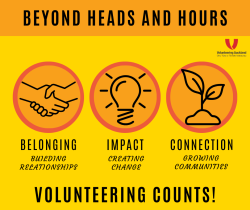Making Volunteering Count: An Investment Worth Making

Volunteers are essential to the success of many community organisations, extending services, building relationships, and enabling missions to reach further than paid staff alone could ever manage.
Across Aotearoa New Zealand, volunteers are the backbone of community-led solutions — supporting everything from food security and mental health initiatives to environmental restoration and cultural programming.
Yet despite their impact, the systems and people required to engage volunteers strategically are too often overlooked when it comes to funding. Very few funders explicitly support volunteer engagement as a core capacity, and many organisations struggle to find resources to sustain even a basic level of volunteer coordination, let alone build effective, future-focused strategies. This lack of investment and visibility creates a cycle that diminishes the potential of volunteering and keeps its value under-recognised and under-leveraged.
The Gap Between Value and Investment
Volunteer engagement is a specialist area of practice that requires skills in relationship management, programme design, equity and inclusion, risk management, training, and impact measurement. Engaging volunteers well is not just about logistics — it’s about aligning people’s time and talent with mission-critical work in a way that is ethical, meaningful, and sustainable.
Yet when it comes to funding, most community organisations cannot secure specific support for this work. Funding is typically geared toward direct service delivery, with an assumption that volunteer engagement will simply “happen” alongside other responsibilities. Some funders are reluctant to support volunteer infrastructure because it is perceived as an administrative overhead rather than an enabler of impact. Others may be interested in volunteer outcomes but lack clear mechanisms or criteria to assess them.
This funding gap leaves organisations in a bind. Without resourcing for dedicated roles, systems, and processes, volunteer engagement remains underdeveloped. Without data that captures the full value of volunteers, it’s difficult to build a strong business case for investment. And without investment, organisations can’t put in place the mechanisms to capture that data. It’s a self-perpetuating cycle that limits what volunteers can achieve — and what organisations can achieve through them.
Beyond Counting Heads and Hours
The most common metrics used to report on volunteering are numbers of volunteers and the hours they’ve contributed. While these are useful as baseline indicators, they fall far short of capturing the true value of volunteer engagement.
Volunteers contribute to outcomes like increased programme reach, improved client relationships, innovation in service delivery, and stronger community ownership. They enhance organisational resilience, bring in new perspectives, and help to build trust in marginalised communities. These impacts are often qualitative, complex, and long-term — and therefore less likely to be reported in standard KPIs.
To make volunteering more visible and better resourced, the sector must invest in measuring the real difference volunteers make. This includes:
- Outcome-based measurement: How did volunteer involvement improve programme quality or participant experience?
- Capacity building indicators: What new services or expanded reach were made possible through volunteers?
- Social capital contributions: How have volunteers helped build community connection or civic participation?
- Volunteer development outcomes: What personal or professional growth have volunteers experienced?
These insights require intentional design, evaluation tools, and staff time — all of which need dedicated resourcing.
Strategic Engagement Must Be a Funding Expectation
While many organisations understand the value of volunteers, not all are equipped to engage them strategically. Volunteer roles may be ad hoc, reactive, or designed without meaningful connection to organisational goals. Volunteer leaders are often isolated from executive teams and not involved in strategic decision-making. Equity and inclusion efforts may be limited, and feedback loops with volunteers absent.
To raise the standard of volunteer involvement and unlock its full potential, we need external mechanisms that encourage or require strategic volunteer engagement. One key opportunity is through funders — especially government agencies and large philanthropic bodies — including volunteer engagement in their grant and contract criteria.
This might include requiring:
- Evidence of a volunteer engagement strategy
- Dedicated staff responsible for volunteer coordination
- Mechanisms for volunteer feedback and input
- Reporting on volunteer outcomes beyond basic numbers
In the same way funders now commonly require organisations to demonstrate cultural responsiveness, environmental sustainability, or partnership with Māori, they could also require a commitment to best-practice volunteer engagement. This would help embed volunteer infrastructure as an expected part of programme delivery, not a nice-to-have.
The Limits of One-Time Funding
Occasionally, funders will support volunteer engagement through one-off capacity building grants — perhaps to develop a strategy, buy software, or pilot a new approach. These investments can be useful, but they are rarely enough on their own. A strategy developed with one-time funding still needs someone to implement it. Software needs someone to manage it. New volunteer programmes need long-term oversight, training, evaluation, and relationship-building.
In short, volunteer engagement doesn’t end with a plan — it requires ongoing operational investment. There is a mismatch between the long-term nature of effective volunteer involvement and the short-term nature of most capacity-building grants. Without continued support, efforts to improve volunteer engagement can stall or regress. For real impact, funding must not only support innovation but also provide core operational resources to embed and sustain strategic volunteer practices.
Towards a New Funding Narrative
To shift the funding landscape, we need to tell a stronger story about the value of volunteering. This includes:
- Framing volunteer engagement as mission-critical: It is not peripheral — it is part of how impact is achieved.
- Demonstrating return on investment: Every dollar invested in volunteer infrastructure enables significantly more value in time, skill, and outcomes.
- Making the case for visibility: What gets measured gets resourced. We need to make volunteering more visible through stories, data, and evidence.
It also means advocacy — engaging with funders to educate them about what strategic volunteer engagement looks like, why it matters, and how it contributes to the outcomes they care about.
A Call to Action
Volunteering has always been a powerful force for good — but for it to flourish, we must invest in the systems and people that make it work. Strategic volunteer engagement is not an overhead — it is a key driver of impact. It's time funders recognised that, and it’s time the sector raised its voice to make it visible.
Because when we invest in volunteering, we’re not just supporting helpers — we’re building stronger, more connected, more resilient communities. And that is an investment worth making.

